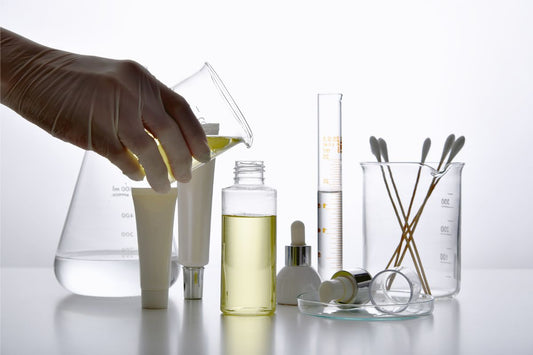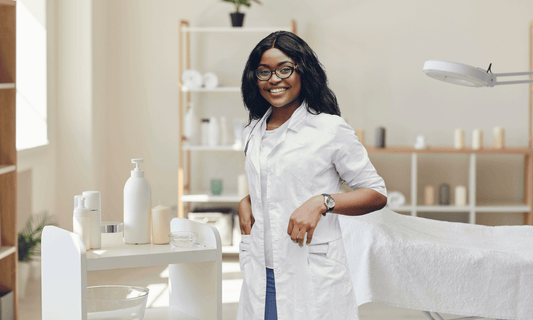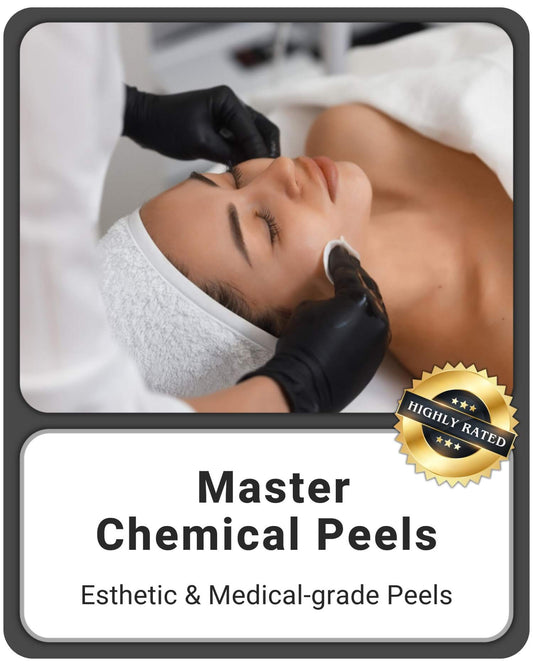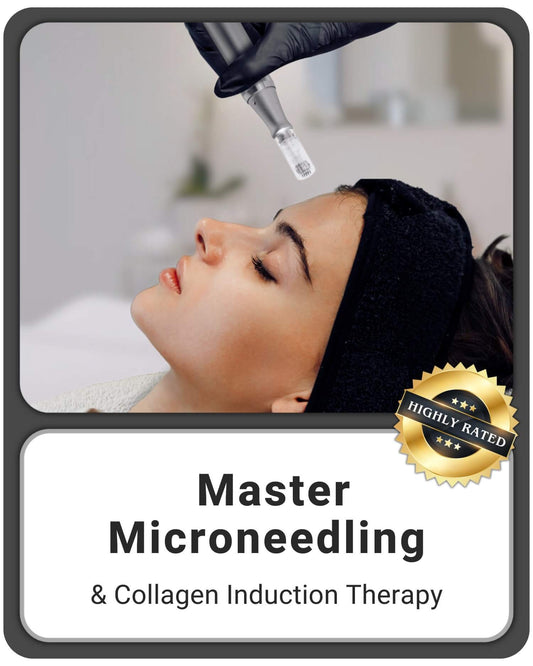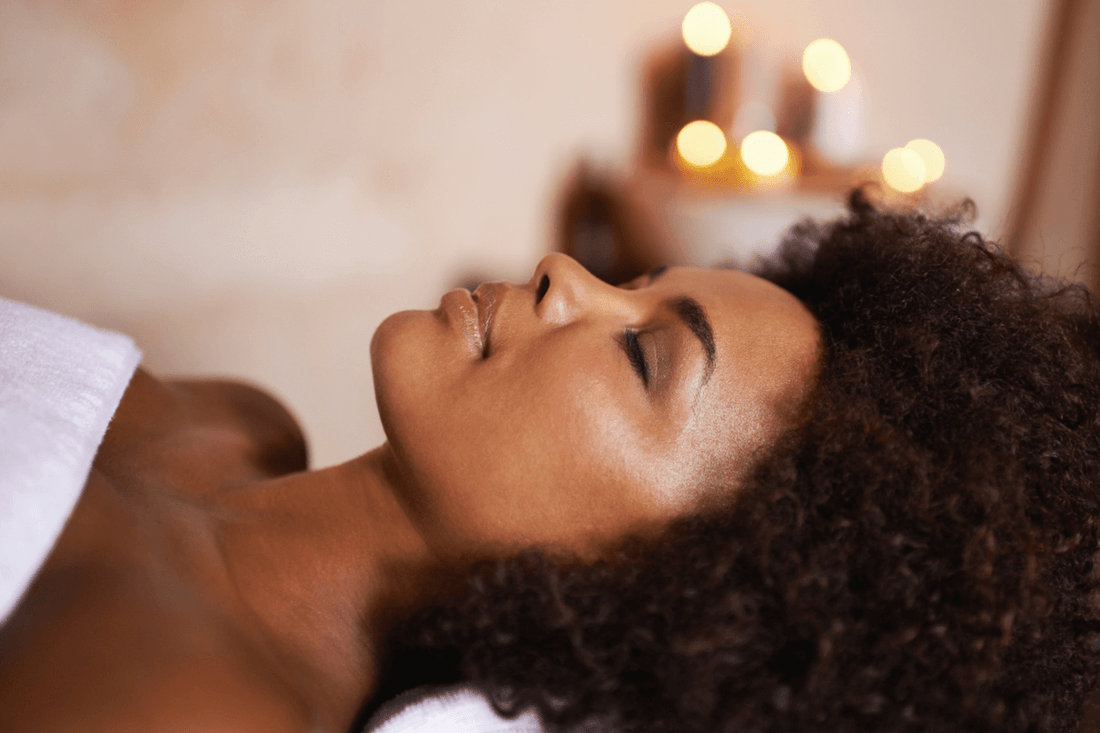
The Importance of Preparing Darker Skin Tones for Aesthetic Treatments
Jen CopferShare
People with darker skin tones (Fitzpatrick Types IV-VI) are more likely to experience adverse reactions to aesthetic treatments like chemical peels and lasers. Fortunately, there are ways to help reduce these unwanted side effects. One extremely important way is to properly pre-treat the skin before receiving aesthetic treatments, which is something both skincare professionals and individuals with darker skin tones should be thoroughly educated on.
Key takeaways:
- Melanin is the pigment in our skin and is produced in response to sun exposure and any form of injury or inflammation to the skin.
- People with darker skin tones have more melanin in their skin, which causes them to be more at risk for pigmentation issues after receiving aesthetic treatments.
- Pre-treating the skin before an aesthetic treatment will help reduce unwanted side effects.
One of the biggest benefits of the aesthetic industry’s continued evolution is that treatments are becoming safer and more inclusive for all skin tones. In the past, due to a higher risk of unwanted side effects associated with darker skin types, individuals with darker skin tones had limited options or were advised to avoid certain treatments altogether.
But even though treatment options have expanded and evolved, that doesn’t mean the risks have gone away. People with darker skin tones are still more likely to experience unwanted side effects like discoloration, hyperpigmentation, or scarring, especially after treatments that cause inflammation or injury to the skin, such as chemical peels, lasers, or microneedling.
The good news is that there are ways to help reduce these unwanted side effects following aesthetic procedures. One way is to properly prepare or "pre-treat" the skin for several weeks before the desired treatment, which will be the focus of this article.
However, in order to fully understand why it's important to pre-treat the skin, you first need to know why people with darker skin tones are more likely to have negative reactions to aesthetic treatments.
The Importance of Melanin

Melanin is the pigment responsible for giving our skin its natural color. It’s produced by melanocytes, which are specialized cells located in the top layer of the skin. The more melanin in the skin, the darker the skin tone.
Did you know?
Everyone, regardless of skin color, has the same number of melanocytes?
The difference is that in darker skin tones, those melanocytes produce more melanin, which gives the skin its color.
The important thing to know about melanin is that it also serves as a protective mechanism in the skin. The skin protects itself by triggering the melanocytes to produce more melanin in response to:
- The sun's harmful UV rays, which is the reason why the skin gets darker with sun exposure.
- Any type of inflammation, injury, irritation, or damage to the skin. For example, this can result from acne, ingrown hairs, wounds, burns, rashes, and some aesthetic treatments.

When stimulated, melanocytes produce excess melanin, which results in dark spots or patches on the skin. This is called post-inflammatory hyperpigmentation, or PIH for short.
People with darker skin tones, also known as "skin of color" or "melanin-rich skin," include many ethnic groups and skin tones, ranging from light tan to black.
These skin tones naturally have more melanin in their skin, which means they are more at risk of their melanin becoming overactive when the skin is injured or irritated. This overactive melanin can lead to PIH. As a result, darker skin tones are more prone to developing PIH.
How Skin Tone Is Classified in the Aesthetic Industry

In the aesthetic industry, most professionals use the Fitzpatrick Skin Type Scale to assess how someone’s skin may respond to treatments. This scale ranges from Type I (very fair, always burns) to Type VI (deeply pigmented, never burns).
While I personally find the Fitzpatrick Scale to be limited and somewhat outdated (it doesn’t account for ethnicity, genetic background, or the wide spectrum within skin of color), it’s still widely used in clinical and aesthetic settings. Because of this, it remains a helpful starting point for treatment planning and risk assessment.
In general, Fitzpatrick Types IV–VI are considered “darker skin tones” in aesthetics and are more prone to adverse reactions. The higher the Fitzpatrick number, the greater the risk.

Side effects from aesthetic treatments

Chemical peels, lasers, and microneedling are just a few of the many aesthetic procedures that achieve their benefits by causing inflammation or a controlled injury to the skin. This forces the skin to heal itself, which leads to the production of new collagen for skin rejuvenation.
Unfortunately, these treatments can easily trigger PIH in people with darker skin tones due to the way they achieve their benefits.
Aesthetic treatments can also cause other unwanted side effects for people with darker skin tones, including hypopigmentation (a visible spot on the skin that is lighter in color than the surrounding skin) and even scarring.
How to reduce unwanted side effects from skincare treatments

It is important to remember that there is always a risk of PIH or other negative side effects, even when the right treatments are used for darker skin types. Because of this, it is crucial to try to reduce these unwanted side effects as much as possible. Luckily, there are ways to help achieve this.
In order to get the optimal results from your treatment while reducing negative side effects as much as possible, you must do the following:
-
Only go to an experienced provider. Finding a provider with the knowledge, skills, and expertise for treating people with darker skin tones is crucial. Most aesthetic treatments need special modifications and adjustments to safely treat darker skin tones.
-
Proper at-home pre-treatment: prepping the skin before an aesthetic treatment
-
Proper at-home post-care: after-care following an aesthetic treatment
Each of these three tasks is equally important and must be taken seriously.
Pre-treating the skin before an aesthetic treatment
In this article, we will be focusing on the second task: proper at-home pre-treatment.

Properly pre-treating the skin before a treatment prepares the skin to safely receive the upcoming treatment.
Note: The actual pre-treatment protocol will depend on the desired aesthetic treatment, the strength of the treatment, the degree of pigment in the skin, and each person's specific needs. However, I will provide general pre-treatment recommendations and explain why each is necessary.
Before I get into detail about each one, a quick summary of the ways to properly pre-treat the skin are:
- Avoid sun exposure before a treatment
- Start with a healthy skin barrier
- Use topical pigment inhibitors
- Additional considerations for prepping the skin
Skin Prep Tip #1: Avoid sun exposure before a treatment
Most people know the importance of staying out of the sun after getting aesthetic treatments. But did you know that it’s also important to stay out of the sun before some aesthetic treatments?
Remember how the sun’s UV rays cause melanocytes to produce more melanin? Even if the skin does not show visible signs of sun exposure, UV rays still cause melanin to become hyperactive. As a result, PIH is more likely to happen after an aesthetic treatment if the person is in the sun before the treatment.
Tips on sun protection before an aesthetic treatment:
- Avoid direct sun exposure for 2- 4 weeks before the treatment.
- Use a broad-spectrum sunscreen with an SPF of 30 or more, daily, and reapply it every 1-2 hours as needed.
- Tinted sunscreens that include iron oxide and titanium oxide work well for skin of color.
- Wear a wide-brimmed hat outdoors and take additional measures to avoid direct sun exposure, like standing in the shade, if possible.
Skin Prep Tip #2: Make sure you have a healthy skin barrier
Your skin barrier is a protective barrier on the outermost portion of your skin. If the skin barrier is weak or damaged, the skin is more likely to get irritated during aesthetic treatments.
You should never get an aesthetic treatment with a damaged skin barrier because it can lead to PIH.
How do you know if you have a damaged skin barrier?
Some signs include if your skin:
- is severely dry
- is scaly in appearance
- is sensitive to topical products
- feels tight immediately after cleansing
Ways to prevent damaging your skin barrier:
- Avoid cleansing the skin too frequently
- Avoid using harsh or irritating products
- Avoid cleansing with hot water and taking long, hot showers or baths
- Avoid over-exfoliating
- Avoid too much sun exposure
Ways to help support the skin barrier include:
- Use a gentle cleanser for sensitive skin
- Use gentle products that won't irritate or inflame the skin
- Use a barrier repair moisturizer that contains ceramides
Note: If you have acne-prone skin, avoid barrier repair products containing occlusives (like petrolatum) or silicones, which might cause breakouts.
Skin Prep Tip #3: Use a topical pigment inhibitor
Topical pigment inhibitors are products that help calm down active melanin in the skin while also slowing down the production of new melanin. This will hopefully make the melanin less reactive when receiving the aesthetic treatment.
Certain pigment inhibitors, such as hydroquinone, are only available by prescription from your doctor (unless you live in a country where it is unavailable).
Over-the-counter (OTC) pigment inhibitors include kojic acid, arbutin, and azelaic acid.
The duration of use can be anywhere from 2–12 weeks before the treatment. The length of time will depend on your provider’s recommendations.
Note: If any products become irritating, stop using them and inform your provider. Remember, irritation contributes to PIH.
Skin Prep Tip #4: Additional considerations for prepping the skin before an aesthetic treatment
There are other considerations that you should discuss with your provider, such as:
- Some aesthetic treatments, like chemical peels, require the use of additional topical products for several weeks to prepare the skin.
- If you've recently had other aesthetic treatments—waxing, exfoliating, laser, etc.—you may have to wait a certain period of time before getting your desired treatment.
-
Stopping the use of some topical products for 5-7 days before your aesthetic treatment may be required. Common examples include retinoids (tretinoin and retinol), certain pigment inhibitors, or harsh products like benzoyl peroxide and acids.
- Notify your provider if you're taking any medications that make you sensitive to the sun (photosensitizing medications). Never stop taking a medication unless your prescribing doctor tells you to do so.
-
Ask for a patch test of the treatment on a small area of your skin to see how it reacts to it before receiving the actual treatment.
Even though darker skin tones are more prone to negative reactions from aesthetic treatments, there are ways to help reduce the unwanted side effects. Pre-treating the skin for several weeks before an aesthetic treatment is essential to help prepare the skin for the upcoming treatment and reduce the risk of negative side effects.
At a minimum, prepping your skin would include protecting yourself from the sun, maintaining a healthy skin barrier, and applying topical pigment inhibitors.
Resources
- Journal of Drugs in Dermatology. Algorithm for Pre-/Post-Procedure Measures in Racial/Ethnic Populations Treated With Facial Lasers, Nonenergy Devices, or Injectables. https://pubmed.ncbi.nlm.nih.gov/36219060/
- Journal of the Academy of Dermatology. An Update on Cosmetic Procedures in People of Color Part 1: Scientific Background, Assessment, Pre-procedure Preparation. https://pubmed.ncbi.nlm.nih.gov/35189254/
- Journal Of The European Academy of Dermatology & Venereology. Expert Recommendations on Supportive Skin Care for Non-Surgical Procedures. https://onlinelibrary.wiley.com/doi/full/10.1111/jdv.18855
- Clinical, Cosmetic and Investigational Dermatology. Post-Inflammatory Hyperpigmentation in Dark Skin: Molecular Mechanism and Skincare Implications. https://www.ncbi.nlm.nih.gov/pmc/articles/PMC9709857/
- British Journal of Dermatology. Chemical Peeling in Ethnic Skin: An Update. https://pubmed.ncbi.nlm.nih.gov/24098904/
- Lasers in Surgery and Medicine. Acne Scars in Ethnic Skin Treated with Both Non-ablative Fractional 1,5500nm and Ablative Fractional CO2 Lasers: Comparative Retrospective Analysis with Recommended Guidelines. https://pubmed.ncbi.nlm.nih.gov/21956625/


